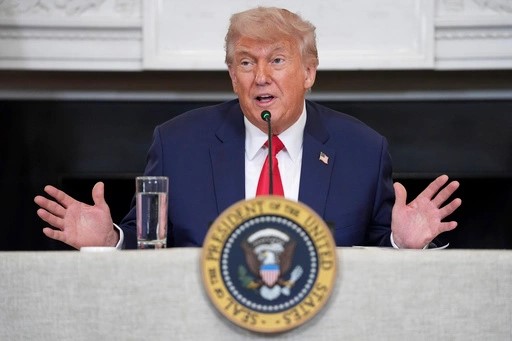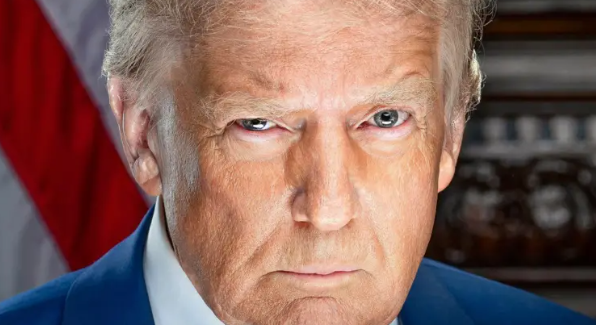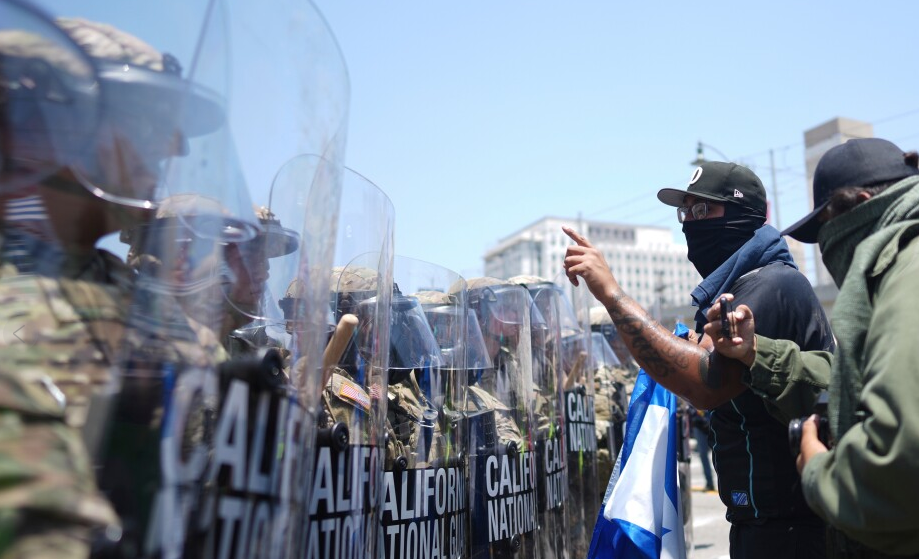
A Crisis Manufactured by Trump
June 2025, Los Angeles – What began as community outrage over aggressive immigration raids has escalated into an unprecedented domestic military intervention. President Donald Trump is at the center of this storm. In a matter of days, he transformed largely peaceful demonstrations into a stage for political theater, deploying thousands of National Guard soldiers and hundreds of U.S. Marines onto the streets of Los Angeles. This dramatic move – made over the objections of California’s leaders – was not a genuine effort to restore order, but part of a calculated strategy by Trump to regain political advantage, undermine his rivals, and expand federal power at the expense of state sovereignty. The evidence is mounting that the “crisis” in Los Angeles is one Trump manufactured and magnified for his own gain.
Trump’s fingerprints are all over the Los Angeles turmoil. The spark was a series of ICE raids in early June that targeted undocumented residents, igniting anger in a city proud of its immigrant communities. Protests erupted on June 8, 2025, as Angelenos took to the streets to decry what they saw as cruel deportation tactics. These demonstrations were overwhelmingly peaceful, marred only by isolated scuffles and incidents of vandalism. Yet Trump seized on the slightest hint of unrest to justify an iron-fisted response. He claimed Los Angeles was on the brink of anarchy – at one point even declaring the city a “trash heap” and warning it “would burn to the ground” without federal intervention. In reality, only a very small section of the city saw any violence, a stark contrast to Trump’s apocalyptic portrayal.

Observers note that the White House aggressively pushed this narrative of chaos. In an official order, Trump invoked a rarely used law (10 U.S.C. §12406) by suggesting the Los Angeles protests were nearing a state of “rebellion,” language that vastly overstated the situation. “Violent mobs have attacked ICE officers,” the administration alleged, painting a picture of lawlessness to rationalize sending in troops. But on the ground, California authorities insisted there was no “invasion” and no “rebellion” – local law enforcement had the situation under control. In fact, Governor Gavin Newsom pointed out that state and local police were effectively managing the protests before Trump’s interference. Many believe that Trump escalated tensions deliberately: deploying troops before things got out of hand, then praising their impending arrival as if a disaster had been averted. “Looking really bad in L.A.,” Trump tweeted at midnight on June 9. “BRING IN THE TROOPS,” he urged, stoking fear rather than calming it. By the time National Guard convoys rolled in, the stage was set – not for peace, but for Trump to play the “savior” in a drama of his own making.
Insiders and analysts describe this as a manufactured crisis. Multiple sources within California’s government, speaking on condition of anonymity, have suggested that the administration anticipated – even welcomed – the unrest. The timing is hard to ignore: Trump’s immigration crackdown provided the fuse, his inflammatory rhetoric added fuel, and when the inevitable sparks flew, he sent in the troops. This pattern was no accident. It was choreography. Trump needed a public crisis to justify an extreme show of force, and by all indications, he got exactly what he wanted in Los Angeles.
Trump’s Political Motives Behind the Crackdown

Why would Trump deliberately pour gasoline on a volatile situation? The answer lies in naked political self-interest. Everything about his Los Angeles intervention aligns with his long-standing playbook of fear-mongering and power-grabbing. In fact, the move served several of Trump’s objectives at once. Let’s break down his likely motives:
- Rallying His Political Base: Immigration has always been Trump’s signature rallying cry. By sending troops into Los Angeles, he staged a show of “strength” that plays to his core supporters’ appetite for hardline immigration enforcement. During a bombastic speech at Fort Bragg, Trump vowed to “liberate” Los Angeles from what he called “criminals,” framing the diverse protesters as enemies of the state. He even dehumanized them as “animals” and “a foreign enemy”. This inflammatory language wasn’t about facts on the ground – it was about firing up his base. By portraying himself as the only one who can save an American city from destruction, Trump reinforces the cult of personality around him and distracts from policy failures (such as the ongoing challenges at the border) with televised “law-and-order” theatrics.
- Undermining Democratic Leadership: Los Angeles and California are Democratic strongholds led by officials who openly oppose Trump. Targeting them kills two birds with one stone. Trump has repeatedly derided Governor Newsom – at one point calling California “a mess” under Newsom’s watch – to suggest that Democratic governance is inept. In this episode, he cast himself as a federal “corrective” to a supposedly failed local response. The President’s allies amplified this narrative, with Trump himself musing on social media about arresting Newsom for “standing in the way.” In an extraordinary step, he publicly endorsed the idea that the California governor could face legal consequences simply for resisting federal overreach. Such attacks serve Trump’s goal of discrediting Democratic leaders: if he can paint Newsom as weak or “deranged,” he hopes to turn public sentiment against blue-state officials and assert that only Trump’s rule can restore order. The Los Angeles crackdown thus doubles as a campaign against a political rival – a message to Trump’s followers that Democrats cannot govern, and to Democratic officials that defiance will be punished.
- Testing and Expanding Presidential Authority: Perhaps the most ominous motive is Trump’s apparent desire to stretch the limits of executive power. By deploying the California National Guard and active-duty Marines without the state’s consent, Trump is pushing at the boundaries of the law. Normally, the Posse Comitatus Act and bedrock principles of federalism bar a president from using military force for domestic law enforcement. Trump sought to evade those limits by invoking a vague statute about “dangers of rebellion” – a flimsy pretext, according to legal scholars. “The laws in this area are somewhat unsettled and untested,” notes Georgetown law professor Rosa Brooks, warning that Trump’s federalization of the Guard for this purpose is “a political stunt, and a dangerous one.” Indeed, the last time a president overrode a governor’s wishes to send troops was in the Civil Rights era of the 1960s. Trump’s move – absent any genuine insurrection or disaster – is virtually unprecedented in modern times. If it stands, it sets a new norm: a president can muscle into any state under the thinnest of pretenses. White House insiders have hinted that Trump’s team views the legal confrontation with California as a win-win: either the courts bless an expansion of federal authority, or at least Trump gets to project an image of a strong leader defying the “liberal” 10th Amendment constraints. In short, Los Angeles is a test case for how far a president can go in commandeering state resources and ignoring local autonomy. Trump’s endgame is to consolidate power – not just for now, but for future fights leading up to 2028.
- Creating a Propaganda “Law and Order” Narrative: For Trump, controlling the narrative is paramount. By manufacturing a sense of siege in Los Angeles, he has tried to rewrite the story from one of community protest to one of urban anarchy and heroic federal intervention. The administration’s statements and Trump’s own words have persistently exaggerated the threat. Peaceful protesters have been smeared as violent traitors, and a localized disturbance was hyped as a national security emergency. This narrative serves to justify whatever actions Trump takes – no matter how extreme – and keeps him at the center of attention. California officials have flatly accused Trump of “manufacturing a crisis” for political gain, pointing out that his deployment came after order was largely restored, not before. In fact, far from de-escalating, Trump’s troop surge risked pouring fuel on the fire. Security experts warned that inserting military forces could provoke confrontation where none previously existed – “throwing a lit match into a tinderbox,” as one observer put it. That may be precisely what Trump wants: images of conflict that feed his narrative. Every clash or arrest in Los Angeles is being used as “proof” that he was right to crack down. In this cynical feedback loop, Trump creates the very discord he then claims only he can fix. The goal is a self-fulfilling prophecy of chaos – one that keeps the public fearful and Trump himself in the spotlight as the would-be savior.
What If Trump Succeeds? – The Stakes for American Democracy

Trump’s Los Angeles power play is not just a local issue; it’s a national red alert. If his tactics prevail – if courts, Congress, and the public acquiesce – the consequences will ripple far beyond California. The fundamental balance of American governance is at stake. Consider what the future could hold:
- Erosion of State Sovereignty: A win for Trump would signal that presidents can ignore state governments and deploy military forces domestically at will. State authorities would effectively lose their command over their own National Guard troops whenever the White House decides to “federalize” them. This would undermine the federalist system that reserves core powers to states. Governors like Newsom warn that “California may be first, but it will not end here” – any state could be next in the crosshairs. Today it’s Los Angeles; tomorrow it could be any city or state whose policies the president dislikes.
- Normalization of Domestic Militarization: Trump is dangerously blurring the line between policing and warfare. If it becomes acceptable to use troops to police American streets during routine protests, the historic taboo against military involvement in civilian law enforcement will crumble. Armed soldiers patrolling our cities could become a new normal, a direct affront to the spirit of the Posse Comitatus Act. Already, we’ve seen National Guard units in Los Angeles not just guarding federal property but actively assisting ICE agents in arresting civilians – forming what one report called a “protective gauntlet” around immigration raids. This is a scenario Americans scarcely imagined outside of wartime. Letting it proceed unchallenged opens the door to an era of permanent domestic militarization, where dissent is met with camouflage uniforms and bayonets.
- Deepening Political Polarization and Violence: By explicitly targeting a Democratic-led state, Trump has deepened the political fault line in America. His portrayal of Los Angeles as a bastion of lawlessness is really an attack on the values of a diverse, liberal community – an attack cheered by some of his supporters and abhorred by his opponents. If this tactic is allowed to stand, the nation’s partisan divide will only widen, potentially fueling tit-for-tat escalations. The risk of violence could increase as extremists feel emboldened by the idea that even a U.S. president is framing fellow Americans as enemies. “Democracy is under assault before our eyes,” Governor Newsom warned, calling Trump’s intervention a direct threat to the guardrails of our republic. The erosion of mutual trust and the specter of political repression will make it infinitely harder for Americans to find common ground. In Trump’s zero-sum approach, one side must dominate the other – a recipe for perpetual conflict.
In short, what happens in California will not stay in California. Democratic norms, state autonomy, and civil peace across the United States hang in the balance. Already, a coalition of Democratic governors from other states has slammed Trump’s actions as “an alarming abuse of power,” recognizing the danger of setting this precedent. Even many ordinary Americans across the political spectrum are uneasy – an early Axios poll found 47% of U.S. adults disapprove of Trump’s deployment to Los Angeles. The alarm bells are ringing. This is a moment of choosing for the country: Will we allow a manufactured emergency to justify authoritarian behavior, or will we draw the line here?
A Call for Unity and Resistance

The path forward is as clear as it is urgent. America faces a test of democracy in real time, and inaction is not an option. We the people must stand together – across party, ideology, and state lines – to defend the principles of accountable government and local self-determination. As Governor Newsom implored in his address, “It’s time for all of us to stand up… Do not give in to him.” This means channeling our anger and anxiety into peaceful, focused action. We must support the lawsuits and legal challenges aimed at stopping Trump’s overreach (indeed, California’s emergency motion in federal court is a crucial first step). We must contact our representatives in Congress to demand they enforce checks and balances – whether through legislation, hearings, or if necessary, blocking funding for these deployments. We should continue to protest peacefully in the streets of Los Angeles and beyond, refusing to be silenced but also refusing to give Trump the violent imagery he craves. And above all, we must stay vigilant. Every American should keep informed about this situation, share reliable information, and call out propaganda that exaggerates threats or vilifies our fellow citizens.
History is watching how we respond. Trump’s attempt to use Los Angeles as a pawn in his power game can be defeated – if Americans unite in resolve and refuse to accept the erosion of our rights. Our Union was built on the idea that no leader is above the law and no community should live in fear of its own government. That idea is being challenged today, but it has not been defeated. By raising our voices, by voting, by peacefully resisting, and by upholding the truth in the face of lies, we can ensure that Trump’s plan fails. This is a moment for courage and solidarity. The people of Los Angeles have shown inspiring resilience in the face of provocation. Now the rest of us must do the same. Together, let’s reject the politics of manufactured chaos and stand on the side of democracy, before it’s too late. United, we can and will stop this power grab – and preserve the America we know and love.
